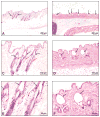Inflammatory and chloracne-like skin lesions in B6C3F1 mice exposed to 3,3',4,4'-tetrachloroazobenzene for 2 years
- PMID: 19737593
- PMCID: PMC2763972
- DOI: 10.1016/j.tox.2009.08.017
Inflammatory and chloracne-like skin lesions in B6C3F1 mice exposed to 3,3',4,4'-tetrachloroazobenzene for 2 years
Abstract
Exposure to dioxin and dioxin-like compounds (DLCs) has been connected to the induction of chloracne in humans and animals. 3,3',4,4'-Tetrachloroazobenzene (TCAB) is an environmental contaminant that induces chloracne in humans. TCAB has been studied only to a limited extent in laboratory animals. While performing a 2-year gavage study in B6C3F1 mice to evaluate the toxic and carcinogenic effects of TCAB, we also explored potential chloracnegenic properties. Groups of 50 male and 50 female B6C3F1 mice were exposed by gavage to TCAB at dose levels of 0, 3, 10 and 30 mg/kg for 5 days a week for 2 years. The animals developed treatment-related gross inflammatory skin lesions, which were characterized histologically by inflammation, fibrosis, hyperplasia, and ulcers. Additionally, many of the animals developed follicular dilatation and sebaceous gland atrophy, consistent with chloracne-like lesions. This current 2-year study supports recently published papers showing susceptibility to chloracne in mouse strains other than hairless mice. The chloracne-like lesions were not clinically evident; therefore, our study highlights the need for careful examination of the skin in order to identify subtle lesions consistent with chloracne-like changes in rodents exposed to dioxin and DLCs. Since previous short-term studies did not demonstrate any skin lesions, we suggest that reliable assessment of all safety issues involving dioxin and DLCs requires evaluation following chronic exposure. Such studies in animal models will help to elucidate the mechanisms of dioxin-related health hazards.
Conflict of interest statement
Figures



Similar articles
-
Toxicology and carcinogenesis studies of 3,3',4,4'-tetrachloroazobenzene (TCAB) (CAS No. 14047-09-7) in Harlan Sprague-Dawley rats and B6C3F1 mice (gavage studies).Natl Toxicol Program Tech Rep Ser. 2010 Nov;(558):1-206. Natl Toxicol Program Tech Rep Ser. 2010. PMID: 21383777
-
Urethral carcinoma and hyperplasia in male and female B6C3F1 mice treated with 3,3',4,4'-tetrachloroazobenzene (TCAB).Toxicol Pathol. 2010 Apr;38(3):372-81. doi: 10.1177/0192623310362708. Epub 2010 Mar 16. Toxicol Pathol. 2010. PMID: 20233943 Free PMC article.
-
Mutation spectra of Kras and Tp53 in urethral and lung neoplasms in B6C3F1 mice treated with 3,3',4,4'-tetrachloroazobenzene.Toxicol Pathol. 2014;42(3):555-64. doi: 10.1177/0192623313491169. Epub 2013 May 23. Toxicol Pathol. 2014. PMID: 23703846
-
Toxicology and carcinogenesis studies of androstenedione (CAS No. 63-05-8) in F344/N rats and B6C3F1 mice (gavage studies).Natl Toxicol Program Tech Rep Ser. 2010 Sep;(560):1, 7-31,33-171 passim. Natl Toxicol Program Tech Rep Ser. 2010. PMID: 21037592 Review.
-
Dioxin-induced chloracne--reconstructing the cellular and molecular mechanisms of a classic environmental disease.Exp Dermatol. 2006 Sep;15(9):705-30. doi: 10.1111/j.1600-0625.2006.00476.x. Exp Dermatol. 2006. PMID: 16881967 Review.
Cited by
-
Cutaneous Effects of In Utero and Lactational Exposure of C57BL/6J Mice to 2,3,7,8-Tetrachlorodibenzo-p-dioxin.Toxics. 2021 Aug 20;9(8):192. doi: 10.3390/toxics9080192. Toxics. 2021. PMID: 34437510 Free PMC article.
-
Proceedings of the 2010 National Toxicology Program Satellite Symposium.Toxicol Pathol. 2011 Jan;39(1):240-66. doi: 10.1177/0192623310391680. Epub 2010 Dec 21. Toxicol Pathol. 2011. PMID: 21177527 Free PMC article.
-
Effects of in utero exposure of C57BL/6J mice to 2,3,7,8-tetrachlorodibenzo-p-dioxin on epidermal permeability barrier development and function.Environ Health Perspect. 2014 Oct;122(10):1052-8. doi: 10.1289/ehp.1308045. Epub 2014 Jun 6. Environ Health Perspect. 2014. PMID: 24904982 Free PMC article.
References
-
- Allen JR, Barsotti DA, Van Miller JP, Abrahamson LJ, Lalich JJ. Morphological changes in monkeys consuming a diet containing low levels of 2,3,7,8-tetrachlorodibenzo-p-dioxin. Food Cosmet Toxicol. 1977;15:401–410. - PubMed
-
- Anderson C, Hehr A, Robbins R, Hasan R, Athar M, Mukhtar H, Elmets CA. Metabolic requirements for induction of contact hypersensitivity to immunotoxic polyaromatic hydrocarbons. J Immunol. 1995;155:3530–3537. - PubMed
-
- Agency for Toxic Substances and Disease Registry (ATSDR) Toxicological Profile for Chlorinated Dibenzo-p-dioxins. Atlanta, GA: 1998. - PubMed
-
- Agency for Toxic Substances and Disease Registry (ATSDR) Toxicological Profile for Polychlorinated Biphenyls (PCBs) Atlanta, GA: 2000. - PubMed
-
- Bailer AJ, Portier CJ. Effects of treatment-induced mortality and tumor-induced mortality on tests for carcinogenicity in small samples. Biometrics. 1988;44:417–431. - PubMed
Publication types
MeSH terms
Substances
Grants and funding
LinkOut - more resources
Full Text Sources

